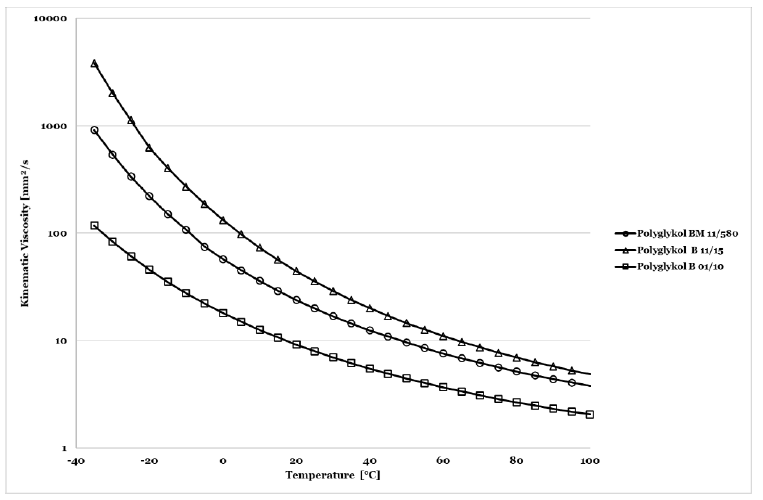Enhanced TDS
Identification & Functionality
- Blend
- No
- Chemical Family
- Fluids & Lubricants Functions
- Product Code
- MITM15287
- Single Ingredient
- Yes
- Technologies
- Product Families
Features & Benefits
Applications & Uses
- Applicable Processes
- Compatible Polymers & Resins
- Fluids & Lubricants End Use
- Fluids & Lubricants Type
- Markets
- Applications
- Product Applications
Fields of industrial application:
- Low viscous base oil component for high performance lubricants with low friction coefficients, excellent wear properties and good thermal stability.
- Base oil for manufacturing greases with good low temperature behavior.
- Lubricity improver for fully synthetic metal working fluids.
Properties
- Physical Form
- Soluble In
- Note
- Typical Properties are for guidance only and not to be taken as product specifications. The tolerances are given in the product specification sheet.
- * Contact angle of water on V2A steel: 64°.
- ** Surface tension of water: 71.6 mN/m.
- Product Properties
- POLYGLYKOL BM 11/580 is a clear, neutral viscous liquid at room temperature. It displays an extremely low solidification point of lower than -62°C and no evaporation loss even at temperatures as high as 100°C.
- POLYGLYKOL BM 11/580 has a very high viscosity index of around 210 despite its low molecular weight. It is soluble in both water and low viscous naphthenic oil.
Technical Details & Test Data
- Viscosity/Temperature Behaviour of Polyglykol BM 11/580
Polyglykol BM 11/580 is the ideal component for low temperature applications. As shown in Figure 1, the viscosity of Polyglykol BM11/580 is relatively low even at -40°C.
Figure 1: Temperature – Kinematic viscosity scan:

- Thermo-Oxidative Degradation
To increase the thermo-oxidative stability, Lubricant Additive 1655 (LA 1655) can be used:
Addition of
LA 1655Temperature
5% mass lossTemperature
10% mass lossCenter
point TInflection
point TResidue °C °C °C °C °C 175.8 187.9 222.3 234.5 0 + 3% LA
1655216 236 261.6 268.3 1.3 + 8% LA
1655222 245 278.8 289.2 3.8 - Elastomer Compatibility - EPDM
Compared to mineral oils and esters, such as TMP trioleate esters, Polyglykol BM 11/580 has a very good compatibility with EPDM sealings:
Base oil Mineral oil HLP 46 Polyglykol BM 11/580 +4% Lubricant Additive 1655 Nᵃ⁾ Ester TMP Trioleate based Hydraulic Fluid ISO 4925 Requirements
Relative Change in Volume 1.17 0.06 0.49 Min. 0%,
Max. 10%
Change in Hardness IRHD 33 -3 -24 Min. 0%,
Max. -15
- Conditions: EPDM RM 69, 100°C, 7d, Average of two measurements.
- ᵃ⁾ Lubricant Additive 1655 N - additive package designed for polyglycols to improve oxidation stability, corrosion, and EP/AW properties. Replaced with Lubricant Additve 1655.
Packaging & Availability
- Packaging Type
Principal Information
- Group Principal Number
- S000004
- Principal
Storage & Handling
- Storage Conditions
When stored in a cold, dry place in a closed container POLYGLYKOL BM 11/580 can be kept for at least two years.
Other
- Appearance
- Clear viscous liquid
- Appearance (SDS)
- Liquid
- Color (SDS)
- Light yellow
- Item Number
- Odor (SDS)
- Characteristic
- Other Hazards
- None known
- Protect from Freezing
- Yes
- Temperature Control
- No
- USA/DOT UN Number
- Not Applicable
- Chemical Properties
Value Units Test Method / Conditions pH 5.0-7.0 - DIN EN 1262 10% w/w solution in water - Material Composition
Value Units Test Method / Conditions Potassium Content max. 10.0 ppm ppm Sodium Content max. 10.0 ppm ppm - Mechanical Properties
Value Units Test Method / Conditions Contact Angle 33.9 - 5% in aqueous solution*, V2A Steel Scar Diameter 0.55 - DIN 51350-3B 300N, 1 hr Weld Load 1200.0 N N - Optical Properties
Value Units Test Method / Conditions Color Scale max. 100.0 APHA APHA Refractive Index 1.4464 - DIN 51432 at 20°C - Physical Properties
Value Units Test Method / Conditions Cloud Point 62.5 °C °C 1% aqueous solution Cloud Point 50.0 °C °C 5g in 25g 25% BDG Density 1.0 g/cm³ g/cm³ DIN 51757 at 20°C Flash Point 199.0 °C °C DIN 51376 Molecular Weight 1400.0 g/mol g/mol Pour Point max. -72.0 °C °C ASTM D7346 Pour Point max. -62.0 °C °C ISO 3016 Viscosity 23.0 mm²/s mm²/s DIN 51562 at 20°C Viscosity 12.7 mm²/s mm²/s DIN 51562 at 40°C Viscosity Index 210.0 - ASTM D2270 - SDS Physical and Chemical Properties
Value Units Test Method / Conditions Autoignition Temperature (SDS) 644.0 °F °F DIN EN 14522 Boiling Point (SDS) min. 572.0 °F °F Decomposition Energy (SDS) 353.0 kJ/kg kJ/kg mass Decomposition Temperature (SDS) approx. 657.0 °F °F Density (SDS) approx. 1.005 g/cm³ g/cm³ DIN 51757 at 50°C Flash Point (SDS) approx. 322.0 °F °F ASTM D92 Flash Point (SDS) approx. 322.0 °F °F Closed Cup Kinematic Viscosity (SDS) approx. 12.7 - DIN 51562 at 40°C Log Partition Coefficient (Log Pow) (SDS) 0.88 - Log Pow, n-Octanol/Water Solidification Point (SDS) approx. -58.0 °C °C ASTM D1177 Vapor Pressure (SDS) max. 0.001 - At 68°F Viscosity (SDS) 12.7 mm²/s mm²/s DIN 51562 at 38°C pH (SDS) 5.0-7.0 - at 20°C, 10% Concentration - Shelf Life & Stability
Value Units Test Method / Conditions Shelf Life 2.0 - - Thermal Properties
Value Units Test Method / Conditions Ignition Temperature 340.0 °C °C DIN EN 14522
